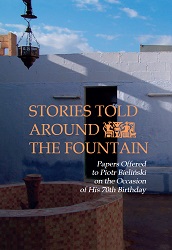O Piotrze, fontannie i Starożytnym Bliskim Wschodzie
About Piotr, a fountain and the Ancient Near East
Author(s): Łukasz Rutkowski, Andrzej Reiche
Subject(s): Archaeology, Ancient World
Published by: Wydawnictwa Uniwersytetu Warszawskiego
Keywords: Ancient Near East; Bronze Age; Piotr Bieliński; seals; sealing practices; Tell Arbid; archaeology
Summary/Abstract: The papers offered in this volume, celebrating Prof.. Piotr Bieliński on his 70th birthday anniversary, cover issues of archaeology, iconography and cult, ceramics and other objects of material culture of the Ancient Near East. The chronological and geographical spectrum of these papers reflects the Jubilarian’s core research field of Bronze Age Near East, concentrating on one hand on northern Mesopotamia and on the other reaching out to the Gulf, his colleagues reach even further beyond, to Egypt, Cyprus and the Roman provinces in southeastern Europe. While the bulk of the papers are set in the Bronze Age, a number of the contributions reach back in time to the Neolithic as well as forward, to Roman and even medieval Islamic times.Five of the 42 papers in general explore topics related to Tell Arbid, a site in northern Mesopotamia that Bieliński brought to the limelight, excavating this primarily Bronze Age city with a long history between 1996 and 2010. The authors, all of them team members, discuss various aspects of ceramics (M. Momot, Ł. Rutkowski,), also in terms of what the Bronze Age diet could have been (J. Piątkowska-Małecka and A. Smogorzewska), bioarchaeological data on women from Tell Arbid (A. Sołtysiak) and the Ninevite 5 infant burials (D. Szeląg and Z. Wygnańska). However, no clear lines can be drawn considering the topics of the presentations as they tend to reach across categories. The Bronze Age landscape, urban and non-urban, of northern Mesopotamia appears in contributions presenting past and current archaeological excavations and ground surveys (R. Koliński, M. Masetti-Rouault and O. Rouault), as well as broader views of the results (K. Jakubiak, A. Reiche, Ö. Tunca). This approach comes through strongly in a series of papers that delve into iconographic studies revolving around various aspects of religion and cult, mythology and ruler representationsfrom the Bronze Age through the times of the Roman Empire (L. Bachelot, M. Bietak, P. Dyczek, K. Gawlikowska and M. Gawlikowski, H. Meyza, A. Otto and B. Einwag, R. Pierobon Benoit, P. Steinkeller, I. Zych), including text-based approaches (O. Drewnowska, P. Michałowski, P. Taracha).A special place among these studies have papers devoted to seals and sealing practices, in Mesopotamia (C. Kepinski, M. Luciani, D.J.W. Meijer, P. Steinkeller) and in the neighboring regions in different periods (M. Iskra, A. Pieńkowska). Royal serekhs stamped on jars are cited as evidence for early rulers from the Nile Delta trading extensively with the Near East (K.M. Ciałowicz). Material culture appears also in contributions on Neolithic building materials (M. Białowarczuk), dress and accessories (S.N. Amirov and Y.V. Lun’kova), reworked ivory pieces and animal-shaped amulets (F. Pinnock, C.E. Suter), craft discoid loom-weights for weaving (A. Ulanowska), and a variety of ceramics, from Bronze Age (M. Kelly-Buccellati, D. Lawecka, Ł. Rutkowski) through Hellenistic (M. Momot) to Islamic (M. Mierzejewska). Drumming up interest in non-material culture is a study of early Mesopotamian percussionists (P. Michałowski).It is a sign if the breadth of the Jubilarian’s life achievement that the volume also includes papers on modern documentation standards and their development citing examples from the history of Near Eastern archaeology and current fieldwork (M. Rekowska and W. Nowakowski, P. Zakrzewski), conservation projects (M. Kowalczyk and M. Olbryś) and creative site maintenance (G. Buccellati). The lattermost ties in with an address by M. Al.-Maqdissi concerning the future of archaeological research in Syria.As is fitting for a Jubilee volume, the opening part introduces Stories about Piotr: the customary brief biography and list of publications, but also four essays on Bieliński, not-only-the-archaeologist (W. Borodziej, S.K. Kozłowski, W. Lengauer, and W. Tygielski) – a very personal look at the academic establishment at the University of Warsaw, the Professor’s alma mater and lifelong place of employment, in the past half a century.
- Page Range: 31-46
- Page Count: 16
- Publication Year: 2019
- Language: English
- Content File-PDF

